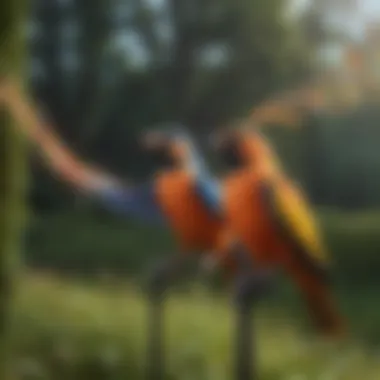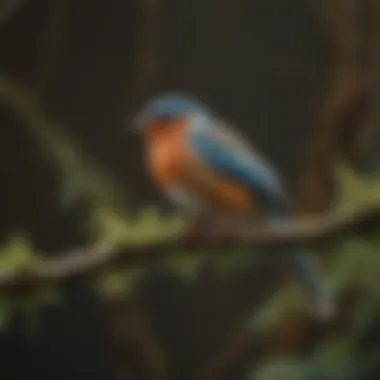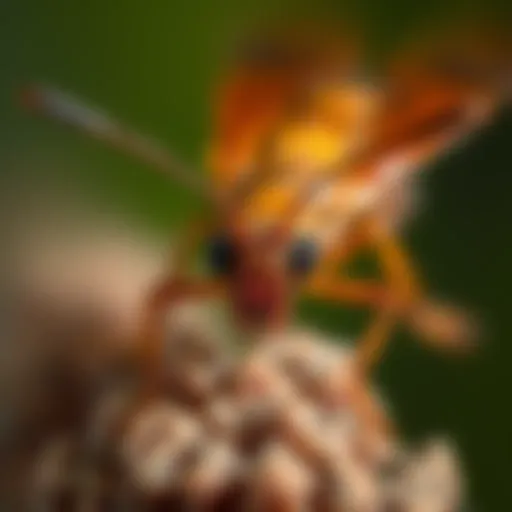Bird Deterrent Streamers: Function and Design Insights


Intro
Birds can be a delightful presence in nature, but they can also become pests when they invade our homes and gardens. This article aims to examine bird deterrent streamers, a practical solution for homeowners grappling with unwanted avian visitors. By understanding how these streamers operate and the implications of their use, one can make informed decisions regarding their implementation.
Understanding Pests
Definition of Pests
Pests are organisms that can cause harm or inconvenience to human activities, especially within domestic spaces. In this context, birds can be classified as pests, particularly when they interfere with property maintenance, contaminate food sources, or disrupt the peace of outdoor spaces.
Importance of Pest Identification
Identifying bird pest species is crucial for understanding their behavior and for implementing effective deterrent strategies. Different species have different nesting habits and feeding preferences. Common offenders may include pigeons, sparrows, and starlings, which can be attracted to urban environments for shelter and food. The first step in managing these pests is recognizing their presence and assessing the extent of the problem.
Prevention Techniques
Home and Garden Preventative Measures
Preventing birds from nesting or feeding in unwanted areas can be greatly enhanced by using bird deterrent streamers. These devices are designed to create a visual and physical barrier that discourages birds from approaching specific zones. Installation near gardens, balconies, or other exposed areas where birds typically gather can significantly reduce their presence.
- Placement: Position streamers where birds are likely to land. The best locations include ledges and rooftops.
- Height: Ensure streamers are hung at varying heights to create an unattractive landing environment.
- Color and Movement: Opt for reflective materials that move with the wind, as this will increase their effectiveness in deterring birds.
Seasonal Prevention Tips
Understanding the behavior of birds in various seasons can also inform prevention strategies. For instance, during spring, many birds seek nesting sites. It is advisable to install deterrent streamers early in the season to prevent nesting attempts. Moreover, maintenance checks are essential as the seasons change, ensuring that streamers remain in good condition and continue to function effectively.
Eco-Friendly Pest Control Solutions
Overview of Sustainable Practices
In recent years, there has been a shift towards more sustainable pest control solutions. Utilizing bird deterrent streamers aligns with this trend, as they do not rely on chemicals or harmful substances. Instead, they offer a non-invasive approach to keep birds at bay while minimizing environmental impact.
Natural Remedies and Their Effectiveness
In addition to streamers, natural remedies can assist in bird deterrence. For instance, using scents that are unpleasant to birds, such as vinegar or essential oils, can further discourage their lingering. However, these methods need to be frequently reapplied to maintain effectiveness, making streamers a more durable solution over time.
"Combining various methods of bird deterrence can lead to better results, enhancing both effectiveness and environmental responsibility."
Adopting a mix of strategies tailored to specific situations ensures the best outcome in managing bird pests. As homeowners consider the use of bird deterrent streamers, understanding these methods will empower them to act effectively.
Foreword to Bird Deterrent Streamers
Bird deterrent streamers are increasingly vital tools for homeowners and property managers who desire control over avian populations in specific areas. The presence of birds can lead to various challenges, including property damage, unsightly droppings, and health risks associated with certain species. Understanding the importance of these deterrents is essential for effective pest management and maintaining a clean environment.
Definition and Purpose
Bird deterrent streamers are designed to disrupt the typical behaviors of birds, preventing them from nesting or feeding in designated areas. These devices utilize visual and physical stimuli to create an intimidating environment for birds. Primarily, their purpose is to:
- Offer a non-lethal solution for managing pest bird populations
- Reduce the likelihood of property damage caused by bird activity
- Maintain cleanliness and hygiene in outdoor spaces
Ultimately, these streamers serve to protect both property and public health by creating an inhospitable atmosphere for birds without resorting to harmful methods.
Historical Context
The concept of utilizing streamers for bird deterrence is rooted in traditional practices that date back centuries. Ancient societies employed similar tactics, with colorful fabrics flapping in the wind to ward off birds from crops and livestock. As human civilization progressed, the design and technology of bird deterrents evolved as well. Modern bird deterrent streamers reflect advancements in material science, incorporating elements that enhance their visual appeal and effectiveness.
Today, these devices are widely recognized in agricultural, residential, and commercial settings and represent a response to the escalating need for humane wildlife management practices.
The historical evolution of bird deterrent strategies illustrates a growing awareness of ecological balance and the importance of protecting bird populations while ensuring human interests are safeguarded.
Mechanisms of Action
Bird deterrent streamers operate on multifaceted principles that engage various senses of birds. Understanding these mechanisms is crucial for homeowners seeking effective solutions to mitigate unwanted avian activity. Each mechanism—visual deterrence, auditory elements, and motion effects—plays a significant role in how effective these streamers are in deterring birds from nesting or feeding in specific areas. By combining these factors, bird deterrent streamers leverage natural avian behavior, making them a practical option for pest management.
Visual Deterrence
Visual deterrence is perhaps the most apparent mechanism at work with bird streamers. Streamers often incorporate bright colors, reflective surfaces, or patterned designs that disturb the visual field of birds. Birds are particularly responsive to movement and abrupt changes in light. The use of reflective materials, such as mylar or metallic foil, serves to generate flashing lights that are unsettling and distracting.
This feature is especially effective in open environments where sunlight can beam off the surfaces to create varied light patterns. Consequently, birds may perceive these streamers as foreign objects, leading them to avoid those areas entirely.
Moreover, the design and placement of visual deterrents are vital. Streamers need to be positioned where they are within the line of sight of flying birds, offering an unobstructed view of the deterrents while they approach.


Auditory Elements
Many bird deterrent models also incorporate auditory elements. Sound can serve as a secondary form of deterrence, complementing visual stimulation. These devices utilize noise to create an unsettling environment for birds. Common sounds might include recordings of predatory birds or distress calls from other avian species.
These auditory cues can heighten birds' awareness, causing them to feel threatened or uneasy. Notably, these sounds work more effectively in some environments than others. Areas with high ambient noise may require louder or more distinct sounds to stand out. However, it’s essential to balance the sound levels so as not to disturb neighboring human inhabitants constantly.
Motion Effects
Motion is a critical factor in how bird deterrent streamers operate. By having materials that flutter in the wind or shake due to air currents, the streamers can create an illusion of activity that birds often associate with danger. Moving elements can evoke a sense of unpredictability, compelling birds to rethink their approach.
The effectiveness of motion can be enhanced by strategically placing multiple streamers in a way that encourages overlapping movements. This overlapping motion creates a chaotic environment, making it increasingly difficult for birds to navigate safely. Additionally, factors like wind speed and direction, which vary by location, will affect how the streamers behave.
In summary, the mechanisms of action—visual deterrence, auditory elements, and motion effects—collectively inform the design and placement of bird deterrent streamers. Recognizing how these factors interplay is vital in maximizing their effectiveness against avian pests.
Types of Bird Deterrent Streamers
Understanding the different types of bird deterrent streamers is crucial for anyone looking to mitigate avian interference in their spaces. Each type possesses unique characteristics that cater to varied environments and bird species. By discerning these distinct categories, homeowners and pest management professionals can make informed decisions about which type best suits their needs.
Reflective Streamers
Reflective streamers are designed to maximize light and enhance visibility. They often consist of materials such as mylar or aluminum foil that can catch sunlight and redirect it in various directions. This quality complicates the visual landscape for birds, creating an unwelcoming environment. Reflective streamers function effectively to disorient species that rely on sight, leading to nesting and feeding avoidance.
Advantages of Reflective Streamers:
- Visibility: Highly effective in bright daylight, these streamers can deter birds by leveraging natural light.
- Durability: Typically resistant to weather elements, ensuring long-term functionality.
- Simplicity: Easy to install and require minimal maintenance.
Flock-Wing Streamers
Flock-wing streamers take a different approach by simulating the appearance of larger birds in flight. These streamers often feature a design that mimics the wings of predatory birds. This design serves to create an illusion of danger, prompting smaller birds to steer clear of the area. The use of movement is another key element, as these streamers sway gently in the wind, enhancing the lifelike effect.
Benefits of Flock-Wing Streamers:
- Predatory Simulation: Effective particularly in areas frequented by smaller bird species.
- Interactive: The movement draws attention, further increasing its deterrent effect.
- Aesthetic Appeal: Can blend harmoniously into outdoor decor while serving a protective purpose.
Holographic Streamers
Holographic streamers incorporate a more advanced design that combines reflective properties with visual depth. These streamers can create a mesmerizing effect that captivates and disorients birds. The spectrum of colors emitted from these streamers can vary with changes in light, adding layers to their deterring capability. Holographic designs prove particularly effective in both sunny and overcast conditions.
Highlights of Holographic Streamers:
- Dynamic Visuals: Changes with viewing angle and light, capable of confusing birds.
- Innovative Design: Represents the latest technology in bird deterrent products.
- Effective Across Conditions: Functions well in various weather scenarios, ensuring consistent performance.
By selecting the appropriate type of bird deterrent streamer, homeowners can significantly reduce avian activity in unwanted areas while maintaining the integrity of their environment.
Installation Guidelines
The correct installation of bird deterrent streamers is crucial for their effectiveness. Proper placement and alignment can significantly enhance their ability to keep birds away from areas where they are not wanted. This section discusses important elements for optimal deployment and the benefits of following thorough installation guidelines.
Selecting the Appropriate Location
Choosing the right site for bird deterrent streamers is essential. The location should be where birds are commonly seen, such as near nesting zones, feeding areas, or along flight paths. A good practice is to observe bird behavior and note their patterns. Placement near trees or open spaces is favorable since these are typical areas for birds to gather. The more strategic the location, the better the streamers will perform in deterring birds.
Some factors to consider are:
- Visibility: Streamers should be placed where they are easily visible to birds.
- Type of Bird: Different species may have preferred locations.
- Surrounding Environment: Urban areas, gardens, and agricultural fields can dictate placement.
Finding that balance will help to ensure the streamers work as intended.
Optimal Height and Orientation
The height and orientation of the streamers impact their functionality. Streamers should be mounted at a height that allows them to have maximum visibility without being obstructed by other objects, such as branches or buildings. Higher placements are often more effective as they can disrupt birds' flight patterns.
In terms of orientation, streamers should be positioned to sway freely in the wind. This motion can create additional visual deterrence. Ideally, they should face the direction from which birds typically arrive. A slight angled orientation may also help catch the light better, increasing their reflective properties.
Safety Considerations
While bird deterrent streamers are designed to prevent avian intrusion, it is important to address safety concerns during their installation. Ensure that the streamers do not create hazards for people or pets. Tying streamers too loosely can increase the risk of tangling, while positioning them too closely to walkways could lead to accidental entanglement.
When installing, consider:
- Materials: Use lightweight, non-toxic options for safety.
- Durability: Choose materials that withstand environmental conditions.
- Wind Resistance: Ensure that the setup can resist wind without causing risk to nearby persons or structures.


"Proper installation not only enhances the effectiveness of bird deterrent streamers but also ensures safety for all nearby."
By adhering to these guidelines, one can maximize the effectiveness of bird deterrent streamers while ensuring a safe and visually appealing environment.
Effectiveness of Bird Deterrent Streamers
Understanding the effectiveness of bird deterrent streamers is crucial for homeowners or pest management professionals. These devices should not only be visually appealing, but they also have to fulfill their purpose: keeping birds at bay. Their effectiveness is determined by several conditions, the species of birds involved, and the duration of their impact.
Conditions Impacting Performance
The efficacy of bird deterrent streamers can be influenced by various environmental factors. Weather conditions, for instance, play a significant role. High winds can render streamers less effective as they may become displaced, reducing their visual impact. Bright light can enhance reflective properties of certain streamers, maximizing their effectiveness during the day. Conversely, low light situations may not showcase these streamers as intended.
Moreover, the type of area also matters. Open fields may see better performance from streamers because there are no obstructions blocking their movement or visibility. In contrast, crowded urban spaces may hamper their effectiveness. A proper assessment of these conditions is necessary for optimal placement.
Species-Specific Responses
Different bird species exhibit distinct behavioral patterns and reactions to deterrent streamers. For example, larger birds such as crows or gulls may not be deterred easily by reflective surfaces, as they can become accustomed to such stimuli. Smaller birds, like sparrows, might react more significantly to the movement and sparkle of streamers.
Understanding the specific species in the target area is vital. Some thorough research on local bird populations can inform which streamer types might be most effective. Streamers might also need to be rotated periodically to prevent birds from adapting to their presence.
Long-Term Efficacy
The long-term efficacy of bird deterrent streamers is another area worth exploring. Over time, birds can become tolerant to consistent stimuli. Therefore, it is essential to monitor their effectiveness regularly. This observation can reveal patterns in bird behavior, which may inform adjustments to your deterrent strategy.
In some cases, combining streamers with additional deterrent strategies, like visual decoys or sound devices, can sustain their effectiveness. This multifaceted approach is beneficial in preventing birds from returning. Regular assessment and adaptation of strategies ensure that streamers continue to function as intended over longer periods.
The effectiveness of bird deterrent streamers hinges not only on initial placement but also on continuous evaluation and adjustment according to the unique environment and species involved. It is a dynamic process that requires active management to maintain a pest-free space.
Comparative Analysis with Other Bird Deterrents
Understanding bird deterrent streamers in the context of other bird control methods is essential for making informed choices. Each type of deterrent has its own advantages and limitations. By comparing bird deterrent streamers with other options available, homeowners can select the most effective strategy for their specific needs. The analysis also sheds light on factors such as cost, ease of installation, and environmental impact. In this way, a comprehensive approach can be formulated, which may combine several different systems to maximize effectiveness.
Network of Spikes
Network of spikes is a popular choice for preventing birds from roosting in certain areas, particularly on ledges and railings. These spikes create a physical barrier that discourages birds from landing. Unlike streamers, which rely on movement and light, spikes are a static solution. The installation of spikes is relatively straightforward, making it accessible for homeowners.
However, the effectiveness of spikes can depend on the type of birds being targeted. Some small birds may find ways to land, while larger birds generally avoid these barriers. Maintenance is also a consideration, as spikes require regular checks to ensure they are not obstructed by debris or bird remains.
Ultrasonic Devices
Ultrasonic devices offer a modern method of bird deterrence. These devices emit high-frequency sounds that are unpleasant to birds but typically inaudible to humans. They can be particularly effective in repelling certain species, especially in indoor settings or confined spaces.
One key advantage of ultrasonic devices is that they can cover larger areas without the need for visual obstructions. However, some birds may become accustomed to the sound over time, reducing overall effectiveness. Installation varies by product, and placement is crucial to ensure that the sound waves reach the intended areas. Additionally, ultrasonic devices may also affect non-target wildlife, which raises concerns about their ecological impact.
Visual Decoys
Visual decoys serve as another mitigative strategy against bird infestations. These may include replicas of predators, such as owls or hawks, which can intimidate smaller birds. Decoys are frequently used in agricultural settings or gardens to protect crops from being eaten.
While they can be effective in the short term, their success often diminishes over time as birds learn that the threat is not real. Regular repositioning and maintenance are necessary to keep them effective and in view. Decoys also tend to lack the dynamic aspects that streamers provide, which leverage light and movement to detour birds more effectively.
In summary, while bird deterrent streamers provide a unique combination of visual and physical deterrence, they are not the only solution. Each option, whether it’s spikes, ultrasonics, or visual decoys, offers specific benefits and challenges. Evaluating these methods on a case-by-case basis allows homeowners to deploy the most suitable bird control strategies tailored to their environment.
Environmental Considerations
Understanding the environmental implications of using bird deterrent streamers is essential for any effective pest management strategy. As households and businesses seek means to manage bird populations, it is necessary to examine how these actions influence the ecology surrounding them. Streamers provide a non-lethal method of deterring birds, which is a significant consideration in preserving local wildlife.
Impact on Non-Target Species
Bird deterrent streamers primarily target specific avian species that can cause issues, such as nesting or foraging around buildings. However, the potential impact on non-target species warrants careful thought. Many birds share habitats and food sources, which means that while the intended targets may be deterred, others, including beneficial species, can also be affected.
There are several factors to consider:
- Behavioral Changes: The presence of streamers can alter the behavior of birds that are not the intended targets, possibly forcing them to seek alternative foraging or nesting sites.
- Population Dynamics: If certain species are disproportionately affected by deterrent measures, it may lead to population imbalances, impacting the ecosystem.
- Biodiversity: Some deterrent streamers may also dissuade pollinators or other beneficial organisms that are essential for local ecological health.
Sustainability of Materials Used
The sustainability of materials used in bird deterrent streamers is equally important. As the world increasingly emphasizes eco-friendly practices, selecting streamers made from sustainable materials is necessary.
Key aspects to evaluate include:


- Material Source: Opt for streamers made from recyclable or biodegradable materials. This promotes environmental health and reduces long-term waste.
- Manufacturing Processes: Assess the environmental impact of producing the streamers. Brands that use eco-conscious methods contribute positively towards sustainability goals.
- Durability and Longevity: Streamers that resist wear improve overall sustainability. A longer lifespan means less frequent replacements, reducing waste.
- Impact on Surroundings: Streamers should not contribute to litter or pollution, which negatively affects wildlife and ecosystems.
In summation, selecting sustainably produced bird deterrent streamers reflects a commitment to environmentally responsible practices. Households and businesses can reduce their ecological footprint while effectively managing bird populations.
"The ecological emphasis on sustainability and non-lethal deterrents creates a balance between protecting human interests and conserving wildlife."
By addressing these environmental considerations, homeowners can find effective solutions to their bird problems without compromising the health of their local ecosystems.
DIY Solutions and Customizations
The topic of DIY solutions and customizations is critical within the discourse of bird deterrent streamers. Many homeowners seek cost-effective and adaptable methods for keeping birds away from their properties. Creating one’s own bird deterrents allows for personalization based on specific needs, preferences, and local bird species. The journey into DIY solutions entails not only crafting streamers but also understanding the elements that make them effective. This section elaborates on two primary areas: homemade streamers and enhancements for effectiveness.
Homemade Streamers
Crafting homemade streamers can be a rewarding venture. Not only does this approach cut costs, but it also allows for creativity and customization. Some common materials used in making these streamers include:
- Plastic bags: These can be cut into strips and tied to a string.
- Foil: Aluminum foil can be fashioned into reflective pieces.
- Ribbons or tape: These materials can be either glossy or matte to create visual interest.
When constructing homemade streamers, it's important to consider the following:
- Length and Movement: Streamers should be long enough to catch the wind and create movement. A minimum length of three feet is often sufficient.
- Placement: Ensuring the streamers are placed visibly in areas where birds tend to gather increases their effectiveness.
- Color Choice: Bright, eye-catching colors can enhance visibility and deterrence.
By engaging in this DIY process, one can develop an understanding of how various designs function in their specific environment.
Enhancements for Effectiveness
Once homemade streamers are constructed, various enhancements can elevate their effectiveness. These enhancements should focus on maximizing deterrence through improved visual and auditory elements. Consider these options:
- Adding Sound Elements: This may include bells or noisemakers that can create audible deterrence along with visual effects.
- Additional Reflective Surfaces: Incorporating mirrors or shiny plastic can amplify the reflective qualities, creating flashes that disrupt birds' perception in flight.
- Incorporating Motion: Using lightweight materials that flutter or spin in the wind can provide additional motion, making the streamers more noticeable and unsettling to birds.
Implementing these enhancements requires careful thought. For example, ensure that sound elements are not disruptive to neighbors or undesired wildlife.
"Customizing your bird deterrent solutions not only caters to personal satisfaction but also aligns with environmental considerations."
Case Studies
Case studies serve as valuable tools in understanding the efficacy and practical applications of bird deterrent streamers. They present real-world scenarios where these tools have been implemented successfully or unsuccessfully. Through the examination of these contexts, stakeholders—including homeowners and pest management professionals—can derive lessons that are applicable to their unique situations. This section delves into specific instances to highlight key outcomes, methodologies, and the adaptability of bird deterrent streamers in various environments.
Success Stories
In various parts of the world, bird deterrent streamers have demonstrated significant success in keeping birds at bay. One such success involved a small vineyard in California, where the owners faced issues with starlings consuming ripe grapes. After installing reflective streamers, they observed a considerable reduction in bird activity. The combination of visual distractions and movement prevented avian access to the vines effectively.
Another noteworthy case involved a local school in Colorado. They installed holographic streamers around their playground to deter pigeons. Parents reported that after the installation, the number of birds roosting decreased dramatically. The school not only improved the play area for children but also enhanced the overall aesthetic, as the streamers added a distinctive shimmer to the environmental landscape.
These examples underline how strategic placement and selection of bird deterrent streamers can lead to successful results. Such initiatives create a safer and more pleasant environment by minimizing interactions between birds and human spaces.
Failures and Lessons Learned
Despite the success stories, there are instances where the implementation of bird deterrent streamers met with challenges. A significant example is a park in Florida that opted to use motion-activated streamers to resolve problems with geese congregating around recreational areas. Unfortunately, the method did not maintain efficacy over time. The geese adapted to the streamers, leading to nullified deterrence.
From this failure, several critical lessons emerged. Continuous education and adaptation are vital. In environments subject to specific species, it’s crucial to consider regular updates or adjustments in methods employed. Additionally, stakeholder engagement, including feedback from park users, can enhance strategies to meet changing patterns.
The effectiveness of bird deterrent streamers is not static; it requires ongoing evaluation and readiness to adapt to the behavioral patterns of the birds in question.
In summary, case studies of bird deterrent streamers illuminate both successes and failures. They provide practical insights for homeowners and professionals alike. By learning from these cases, more informed decisions can be made to ensure effective bird management practices.
Epilogue and Future Directions
The discussion around bird deterrent streamers illustrates a vital ppart of wildlife management and home maintenance. These devices serve not only as visual and acoustic barriers to birds, but also contribute significantly to maintaining a harmonious environment for all species involved, including humans.
Summary of Findings
This article provides comprehensive insight on bird deterrent streamers. We explored their mechanisms of action that leverage visual elements, motion, and sound to discourage birds from specific areas. The effectiveness of these streamers varies based on factors such as environmental conditions and the species of birds targeted. Key findings from the research include:
- Types of streamers: Reflective, flock-wing, and holographic designs each have unique properties that affect their efficiency.
- Installation: Proper placement is crucial. The height, angle, and location can greatly influence the success of the deterrent strategy.
- Impact assessment: While bird deterrents aim to protect properties, their ecological consequences must be factored in to avoid harm to non-target species.
Overall, bird deterrent streamers offer a practical, environmentally friendly solution for managing nuisance birds effectively.
Further Research Opportunities
The field of bird deterrent technology continues to evolve. Future research could aim at the following areas:
- Innovative Designs: Exploring new materials and designs that enhance durability and effectiveness.
- Behavioral Studies: Detailed studies on the behavioral responses of various bird species to different types of deterrents could lead to more tailored solutions.
- Long-Term Effects: Investigating the long-term impact of streamers on bird populations and neighborhoods would help assess the sustainability of their use.
- User Feedback: Gathering data from homeowners who regularly use deterrents can provide valuable insights for product improvement.
Further exploration of these avenues not only aids homeowners and pest management professionals but also promotes a deeper understanding of avian behavior and ecology.
Investing in research enhances both the effectiveness of bird deterrents and their ecological sustainability.



